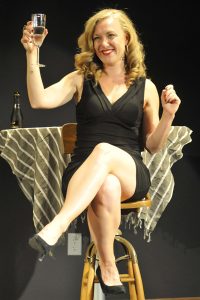
In “My High-Heeled Life: Or, How I Learned to Keep Worrying and Love My Stilettos”, we hear the deep and intimate confessions of Katharine McLeod, an avid shoe-lover trying to balance the materialism of our society with personal happiness. As she sips a glass of champagne while wearing a beautifully pleated silk evening dress and matching black heels, Katharine opens the show in contemplation of how she came to be obsessed with the latter.

Like most objects that hang in our closets, shoes can evoke feelings of happiness or joy; they may remind us of a first dance, a first job, the day you said "I do". As McLeod puts it, "[Forget] diamonds, shoes are a girl's best friend!" Even cleaning -- a task she usually finds daunting -- feels more liberating with a high, swanky heel. And when life gets her down, a trip to the nearest shoe department can lift her spirits, as well as the length of her legs.
Over the course of the play, Katharine takes us through the history of the heel: the very first was made of wood, worn by high-ranking military riders for functionality. In later centuries, heels were worn by men of royal ranking and represented power. In the 1980s, women rejected stilettos, instead wearing flat shoes, collared shirts, and suits in the workplace in their bid for equality. Over the past few decades, Russia and Washington, D.C. have been hosting annual 'shoe races', which encourage participants to dress their best and run for 50 meters in their high-heels of choice. Today, pointy heeled stilettos are so widely available, anyone can own them -- and why shouldn't we indulge in the opportunity to slip on a pair to feel sexy, confident, or empowered? While today there may be some negative attention centered on stilettos, McLeod focuses on the ways in which they can improve one's mood, attitude, and self-esteem. Their role in her wardrobe is as psychological as it is aesthetic.
Nearing the end of the performance, Katharine digs deep into her heart and her soul, revealing raw emotional truths about her own insecurities in relation to her happiness. Is it wrong that she quiets the doubtful, anxious voices of her mind with a pair of shoes? Walking in them, she says, is an art. You must live in the moment, slowing your pace, adding precision to every moment. "Try a pair already," she whispers, then winks, and exits stage right.